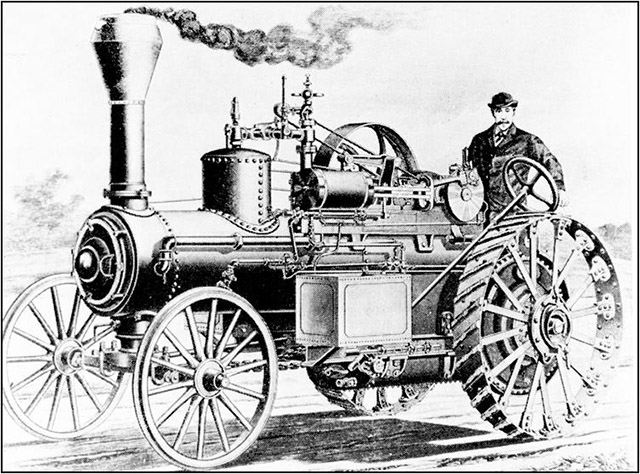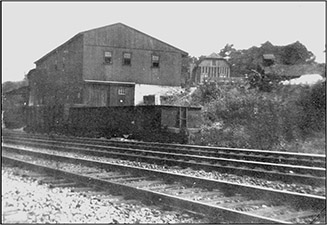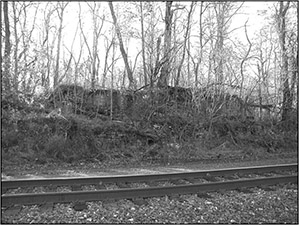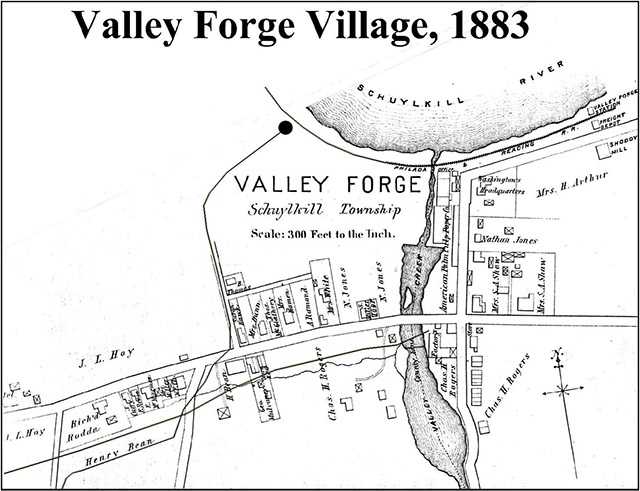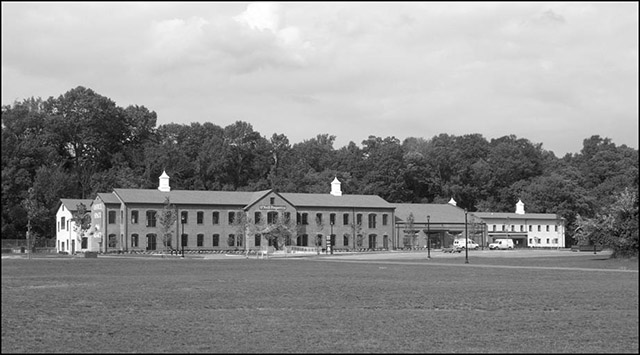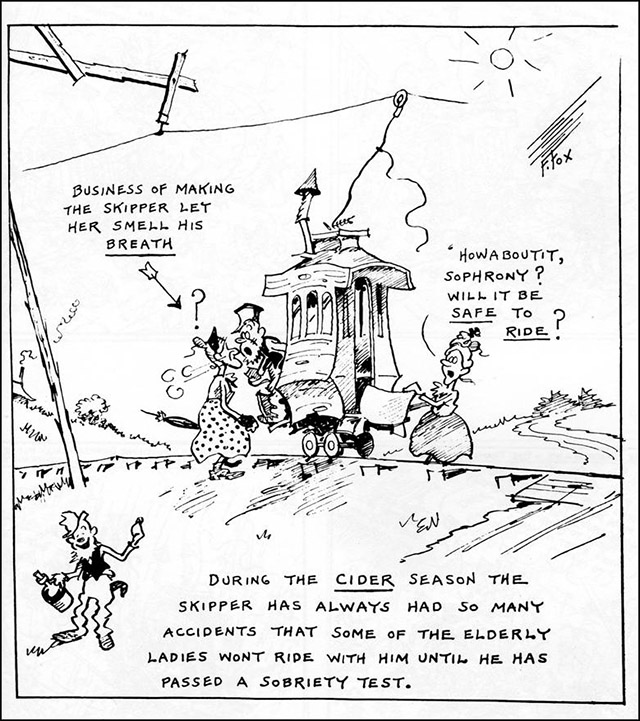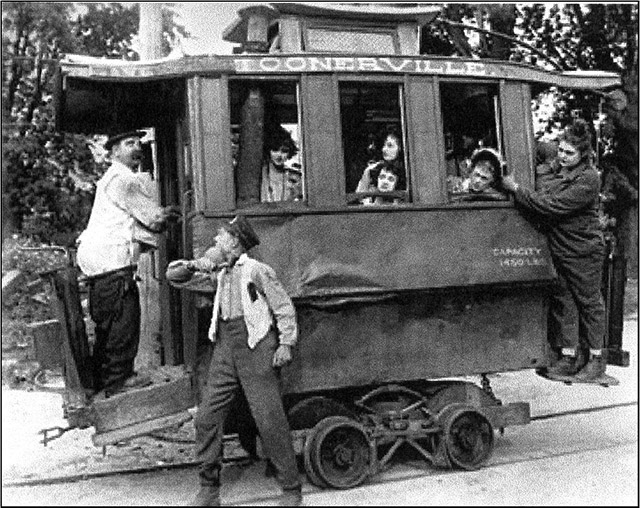|
Home : Quarterly Archives : Volume 43 |
||||||||||||||||||||
Tredyffrin Easttown Historical Society |
||||||||||||||||||||
|
Source: Fall 2006 Volume 43 Number 4, Pages 127–133 Sand, Railways and Movies: Hint for using the footnote reference links: Using the “Back” feature of your browser will return to the previous [Note] link location after you read the footnote. The Delete (Mac OS) or Back Space (Windows) keys often perform this function.
All at once we came upon a narrow gauge railway, and being a group who never want to miss anything, we deviated from the trail to follow the railroad to a great sand quarry. Here we saw one of the finest views of our trip, the Great Valley, the beautiful hills on the south side and, of course, each tried to locate Berwyn, Paoli, and Malvern as the High School or church steeple peeped above the trees. This quotation is taken from an article in the second issue of the History Club Quarterly, published in January 1938 which describes a hike taken along the Horseshoe Trail by club members. [Note 1] Where is this conspicuous quarry? Who ran these quarries, and when? What was the route of the railroad? This and other questions will be answered in the following pages. This article details the history of the Bean family sand business and the creation of a narrow gauge railway to take the stone to the Reading Railroad by the Schuylkill River. Additionally it describes the use in movie making by the Betzwood film studio of the narrow gauge railway and the other railway that ran through Valley Forge village—the Phoenixville, Valley Forge, and Strafford railway.
Henry Bean, a farmer, was the first member of the family to come to Schuylkill Township, purchasing land fronting onto the Schuylkill River in 1812 at Pawling's Bridge—or Pawling as it seems to have been known at the time. His son, Nicholas Bean, created a lumber and coal business at Pawling that was started about 1830. The business was initially supplied with materials transported by boats on the Schuylkill Navigation Canal, which opened in 1824. In 1838 the Philadelphia and Reading Railroad was completed along the Schuylkill River and through Pawling and would also have been used to transport goods. The company regularly placed advertisements in the local newspapers. An illustration of the type of business run by Nicholas is shown in the following advertisement: Lumber and Coal Yard The subscriber thankful for the liberal share of custom heretofore received, informs his friends and the public, that he keeps constantly on hand and for sale, at his landing, in Schuylkill township, Chester county, (Pawling's Bridge) a quantity of LUMBER: such as boards, shingles, plank, joists and scantling, such as generally kept in a lumber yard. Also, a quantity of large white and red ash coal, for stoves and grates, sharp mountain egg coal, for smithing, nut, for lime burning or small stoves, bituminous, for smithing. All of good quality, and clean of dirt, either in large or small quantities, delivered if required to order, and will be sold at the most reduced prices for cash, or good acceptances.
NICHOLAS BEAN One of the interesting aspects of this advertisement is the different types and uses of coal. This complicated use of different types of coal must have developed in the few years after the opening of the Schuylkill Navigation Canal. Nicholas and his wife, Mary, had 9 children. His sons included Benjamin Franklin, Henry, and George W. Bean. In 1856 Henry and Benjamin Franklin Bean traveled to Colorado and Kansas—this was before they were territories or states—using ox teams, and visited Pikes Peak and other areas. During the Civil War Benjamin Franklin Bean participated in the battles of the second Bull Run, Chantilly, Antietam, Fredericksburg, and Chancellorsville, rising to the rank of captain. [Note 3]
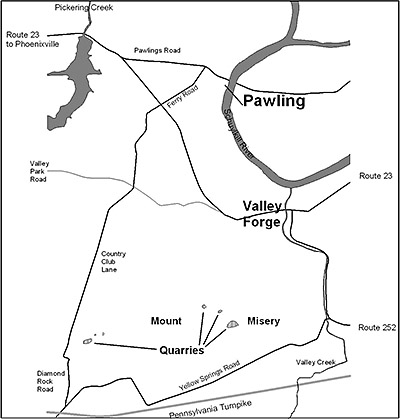
The big curved “C” in the upper right corner is the Schuylkill River. Map courtesy of the author. 
Advertisement from the Phoenixvielle Messenger, In 1860 Henry and Benjamin Franklin Bean set up a company at Pawling, H. & B.F. Bean, to extend the lumber business in a new direction; to crush local quartzite ore into sand. The ore was dug from quarries on Mount Misery close to the intersection of the Horseshoe Trail and Diamond Rock Road. Stone was also quarried for building materials. The advertisement on the right from 1871 illustrates the nature of the expanded business. The North Valley Hills are composed of quartzite. Ancient large sandbanks or off-shore barrier island—like those that exist at present along the Atlantic coast—were with time and compression converted to sandstone. This sandstone was later metamorphosed into quartzite by heat and further pressure. It is not clear how large the Bean business became but in the 1880 census it is reported that the lumber business employed 5 men, paying $1.20 a day to ordinary laborers. The sand produced was especially pure and could be used in the area iron and steel works. There is a valuable deposit of sand near Valley Forge, which is used as a lining or covering for the bottom of the heating-furnaces in the pipemill, Reading, Pa. Most linings would not stand the heat of these furnaces, but this sand is infusible. I was requested to examine it, and found on analysis that it is composed of fine grains of very pure quartz, free from iron, and not a trace of feldspar or any material that would flux with it was found... Of recent years quartz has a new use in the arts: when found pure and white and free from impurities it is mined and made into sand-paper, and is used as a polisher of metals softer than steel. It has been mined at Bridgeport and Valley Forge for this purpose. [Note 4] The rock was hauled from Mount Misery to Pawling initially by wagons and heavy teams. Then in 1885 the teams were replaced by a steam traction engine. [Note 5] The engine could haul 3 wagons each carrying 6 tons of rock. It must have been quite a sight puffing up and down the hill from the quarries to Pawling. The quartzite was crushed at Pawling, loaded onto railroad wagons, and then sent to various locations and factories. In 1895, and again in 1897, B. F. Bean approached the Philadelphia and Reading Railway Company with the idea of building a spur line from Perkiomen Junction—near Pawling—to the quarries. The railway company was not interested due to the cost of building a track with reasonable grades, the limited possible revenue, and the poor credit of Bean.
Steam engine from Whereby We Thrive: A History of American Farming, 1607-1972 by John T. Schlebecker, Iowa State University Press, 1975.
Nicholas Bean died in 1878. Henry and Benjamin Franklin had borrowed money from their father; more than they were to receive in inheritance. Henry and Benjamin Franklin Bean became insolvent. The company could not pay all the monies owed to Nicholas' estate. In 1881 Henry moved to Valley Forge and set up a second sand business there. A large crushing plant was built next to the Reading – Philadelphia Railroad so that the sand could be loaded directly into railroad wagons. An idea of the scale of the business can be obtained from the railroad records. In 1896, for example, the railroad shipped 370 carloads of sand weighing over 10,000 tons. The sand was sent to places such as Pottstown, Birdsboro, Reading, Philadelphia, and locations in New Jersey. 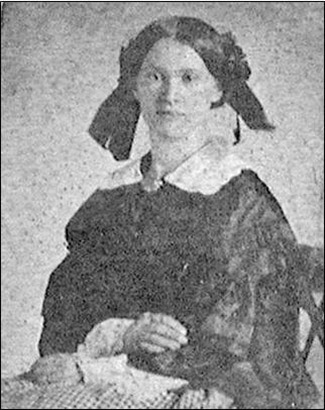
Mrs. Benjamin Franklin Bean, Martha Jane Bean. Photograph courtesy of the Phoenixville Historical Society. A new company, the Bean Fire Sand Company of Valley Forge, was organized in 1888 with Mary Jane Bean (Henry's wife), Martha Jane Bean (Benjamin Franklin's wife), Henry Bean, Benjamin Franklin Bean, and Nicholas Bean (Henry's son) as shareholders. Henry died in 1890, but his wife continued in the business as president. After the death of her husband [Henry], in 1890, Mrs. Mary J. Bean took his place in the management of the stone crushing business at Valley Forge, and has proved herself a shining example of that latent business ability possessed by a large class of American women, who only need some sudden emergency to call into action a power and force of character that might else have never been suspected. She is of German and Welsh descent, and was reared and educated in Montgomery county, where her family is among the oldest and most respected, and has furnished the Commonwealth with a number of active, useful and influential citizens. [Note 6] By 1893 Benjamin Franklin Bean was the manager. In 1894 a dispute among the directors broke out, and B. F. Bean was charged with misappropriating company funds. The following statement to the court describes the issue: Personally came to me Mary Jane Bean who being duly affirmed according to the law declares and says that she was the President or Chairman of the Bean Fire Sand Company, Limited; that Benjamin F. Bean was the Treasurer of said joint stock company or association, limited; that said Benjamin F. Bean as such Treasurer received into his hands, control and possession large sums of money, the property of said Bean Fire Sand Company, Limited, to wit: The sum of seventy-six thousand, five hundred and nineteen dollars and twenty-nine cents ($76,519.29) in cash and checks, of which amount the said Benjamin F. Bean has failed to return to the said, the Bean Fire Sand Company, Limited, or to apply to its uses and purposes a large sum of money, to wit: The sum of $2,240.25, which amount he has embezzled and wrongfully and fraudulently appropriated to his own use and purposes. MARY JANE BEAN
Affirmed and subscribed before me, September 19th 1894, Benjamin said it was all a misunderstanding concerning the account books, but the case did go to trial where he was found not guilty. 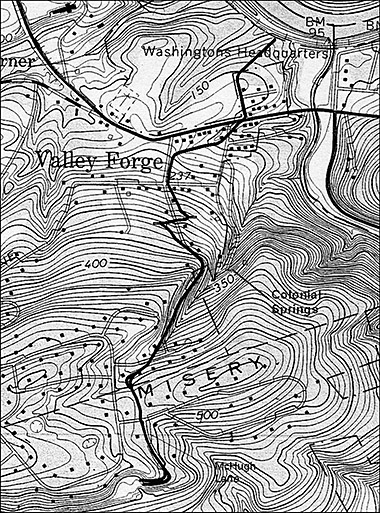
The irregular black line running down the center of this 1966 U.S. Geological Survey map between the Schuylkill River at the top to the quarry at the bottom shows the track of the Mineral Railway. It is also shown crossing Route 23 across the top of the map. Courtesy of the author.
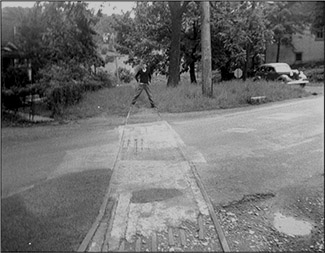
1939 view of the Mineral Railway track crossing Route 23. Ronald Schliefer is shown in the background straddling the track. Photographed by Don Kehl. 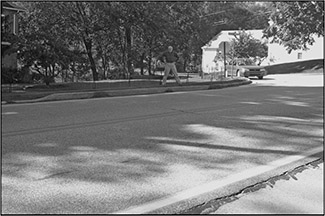
2006 view of the same area of Route 23 as shown in the previous 1939 photograph. Photographed by Kathy King. 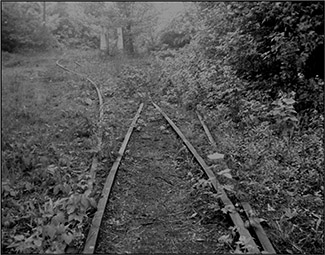
1939 Mineral Railroad track near crushing plant. Photographed by Don Kehl. In 1913 a successor company, the Valley Forge Silica Sand & Ore Company, was incorporated with shareholders Michael F. Hackett, and the two sons of the older Benjamin Franklin Bean, Francis M. Bean and Benjamin F. Bean Jr. In 1915 the company leased land on Mount Misery from Benjamin Franklin Fisher—who had accumulated a large tract of land on the mount—for quarrying. The lease included permission to run a railroad track to the crushing plant—but not to do anything to impair the purity of Colonial Springs, which B. F. Fisher also owned. In 1915, or soon after, the company built a narrow gauge mineral railway. There were a number of quarries on the central and eastern portions of Mount Misery. The largest one was on the south side of the mount. The railway was built to transport the quartzite from this quarry to the crushing plant built next to the Reading Railroad. The traces of the track can be still seen in 3 places: as it leaves the quarry in a western corner of Valley Forge Park, as it crosses the Horseshoe Trail, and at another corner of the Park, near the present top of—the extension of—Davis Road. The railroad then crossed what is now Route 23, and went down Orchard Lane to the crushing plant. The route is all downhill, except for a short section at the start of Orchard Lane. There is over 400 feet of descent between the quarry and the river. Two switchbacks were incorporated in the track due to the steep descent. The rock crusher at Valley Forge was destroyed by fire in 1928 and that seems to have been the end of the business. The tracks of the railway were in place until World War II when they were taken up and used for scrap.
Another railway provided Valley Forge village with passenger service in the early 1900s. This was the Phoenixville, Valley Forge, and Strafford railway (PVFS). There were great plans for this railway. It was envisioned that it would have branches that ran to Strafford, Bridgeport, and West Chester (via Malvern), but only the Phoenixville to Valley Forge section was actually built, terminating by the cotton mill on the east side of Valley Creek.
Village map with routes of the railways.
Sigmund Lubin started making movies in the late 1800s in Philadelphia. As well as making films, he built a chain of over 100 movie theatres in the East. In 1912 he purchased the 500-acre Betzwood estate and built a film studio by the Schuylkill River. Westerns, Civil War films, and railroad adventures were all made at the studio. The studio grounds were used for a lot of productions, but occasionally the village of Port Kennedy and the local limestone quarries were used as backdrops. Lubin developed a strong European market for his movies. This collapsed with the outbreak of World War I. He was also unable to obtain money he was owed and the impact of this bankrupted the studio. In the past few years the area of the studio has been redeveloped. Some of the old buildings have been extended and converted into offices. An apartment complex has also been built in the grounds.
Betzwood Film Studio Buildings. Photograph by the author, September 2006.
In 1919 the owners of the former Lubin Film Company studio at Betzwood looked for a new subject for their movies. They made an agreement with Fontaine Fox, a very successful newspaper cartoonist, to make a series of movies based on his cartoon series, the Toonerville Trolley. [Note 8]
Toonerville Trolley Cartoon. From Fontaine Fox's Toonerville Trolley, compiled by Herb Galewitz and Don Winslow, Scribners, 1972. Two trolleys were built and most of the scenes were shot at Betzwood, but some more interesting topography was wanted.
Toonerville still shot. Courtesy of The Film Institute. It was then decided to use the Mount Misery mineral railway for some action scenes. Fontaine Fox and Dan Mason—who played the “Skipper” of the trolley—decided to take the trolley on a maiden voyage. Unfortunately, the trolley got out of control and Fox had to rock the car to get it off the tracks and prevent a serious crash. After this incident it was decided to focus on the much gentler gradient of the Phoenixville, Valley Forge, and Strafford railway. Only a few of the Toonerville movies have survived. The Skipper's Narrow Escape is one of them. The location of a number of the scenes in this movie can be pinpointed. The opening scene was shot at the bottom of the Horseshoe Trail near Route 23. Another scene was shot from the Route 23 bridge over Valley Creek with the action taking place on the trestle bridge of the PVFS railway over Valley Creek. The 1790s dam over Valley Creek forms a backdrop to this scene. Another scene was shot at Betzwood. This movie is still undergoing analysis to try to locate other scenes and to see if the belief that some of the scenes were shot using the mineral railway can be confirmed.
I would like to thank Jim Brazel, Rick Bates, and Don Kehl for help with aspects of the railway side of this story. Sources
Mike Bertram is a frequent contributor of material about the Valley Forge area. This was a presentation at an October 15, 2006 meeting of the Tredyffrin Easttown Historical Society. |
||||||||||||||||||||
